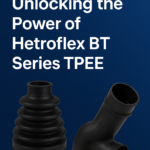
Unlocking the Power of Hetroflex BT Series TPEE for Automotive and Industrial Applications
1 December 2025TPEE vs TPU — Which Material Performs Better in Industrial Use?
In the world of thermoplastic elastomers (TPEs), TPEE (Thermoplastic Polyester Elastomer) and TPU (Thermoplastic Polyurethane) stand out as two leading materials with distinct performance advantages. Both combine the elasticity of rubber and the processability of plastic, but they differ significantly in mechanical strength, heat resistance, and environmental stability.
As a professional TPEE manufacturer, Hetroflex provides an in-depth technical comparison to help engineers, designers, and buyers choose the right material for their specific needs.
1. What is TPEE (Thermoplastic Polyester Elastomer) ?
TPEE is a block copolymer made up of polyester hard segments and polyether or polyester soft segments.
The hard segments deliver strength, stiffness, and thermal resistance, while the soft segments offer elasticity and flexibility.
Key Characteristics of TPEE:
-
Hardness range: Shore D 32–82
-
Excellent mechanical strength and elasticity
-
Outstanding fatigue and dynamic performance
-
Broad service temperature: -70°C to 200°C
-
Superior resistance to oils, fuels, and solvents
These properties make TPEE an ideal choice for applications requiring durability under mechanical stress and extreme temperature conditions.
2. What is TPU (Thermoplastic Polyurethane) ?
TPU is composed of urethane groups (-NHCOO-) formed from the reaction of diisocyanates, polyols, and chain extenders.
Its structure also features hard and soft segments — the hard segments provide strength and hardness, while the soft segments ensure elasticity and flexibility.
Key Characteristics of TPU:
-
Hardness range: Shore A 10–D 75
-
Excellent abrasion resistance and impact toughness
-
Good elasticity across a wide hardness range
-
Service temperature: -50°C to 90°C
-
Highly flexible and transparent
TPU is commonly used where abrasion resistance and flexibility are top priorities.
3. Performance Comparison: TPEE vs TPU
| Property | TPEE | TPU |
|---|---|---|
| Tensile Strength | Higher, especially at high temps | Good, but drops at high temps |
| Modulus (Stiffness) | Higher | Lower for same hardness |
| Abrasion Resistance | Excellent | Excellent, up to 10× better than rubber |
| Flexural Fatigue | Outstanding | Good |
| Stiffness | Higher | Softer and more flexible |
Summary:
TPEE provides superior strength and modulus, enabling thinner part design and better load-bearing performance. TPU, however, remains more flexible and softer, making it perfect for comfort-focused products.
4. Thermal Performance
TPEE exhibits superior thermal resistance, maintaining performance up to 150–160°C, compared to TPU’s limit around 90°C.
TPEE also remains flexible at -70°C, making it ideal for environments with large temperature fluctuations — from automotive engine bays to outdoor industrial parts.
5. Chemical & Environmental Resistance
| Category | TPEE | TPU |
|---|---|---|
| Oil & Fuel Resistance | Excellent | Moderate |
| Hydrolysis Resistance | High (especially polyether-based) | Lower, needs stabilization |
| UV & Weather Resistance | Good inherent resistance | Requires UV stabilizers |
| Fuel Permeability | 1/3–1/300 of oil-resistant rubbers | Higher permeability |
TPEE performs better in chemical, fuel, and heat exposure, while TPU excels in wear resistance and flexibility.
6. Processing Comparison
Both materials are processable with standard thermoplastic methods such as injection molding, extrusion, and blow molding.
However:
-
TPEE offers better melt stability and heat resistance.
-
TPU is easier to mold for complex shapes and softer textures.
-
Both require proper drying before processing to avoid hydrolysis.
7. Application Examples
TPEE Typical Applications
-
Automotive: Air ducts, CVJ boots, seals, wire coatings
-
Industrial: Hydraulic hoses, conveyor belts, flexible couplings
-
Electronics: Cable jackets, high-temperature insulation
-
Consumer goods: Sports equipment, silent gears, elevator tracks
TPU Typical Applications
-
Footwear: Shoe soles, athletic components
-
Industrial: Seals, gaskets, belts, hoses
-
Consumer: Phone cases, protective covers, watch straps
-
Medical: Tubing and catheters
8. Choosing the Right Material
Choose TPEE if your application requires:
-
Operation above 90°C
-
High stiffness and fatigue resistance
-
Fuel and oil resistance
-
Dimensional stability under load
-
Long-term outdoor durability
Choose TPU if your application requires:
-
Excellent abrasion resistance
-
High flexibility and softness
-
Transparency
-
Cost efficiency
-
Service below 90°C
Conclusion
Both TPEE and TPU are exceptional thermoplastic elastomers — but each fits different performance needs.
-
TPEE excels in high-performance, heat-resistant, and load-bearing applications.
-
TPU dominates in soft-touch, abrasion-resistant, and cost-sensitive markets.
As a leading TPEE supplier, Hetroflex provides customized material grades tailored for automotive, industrial, and consumer products.
Our technical team can help you select the right formulation for your next innovation.

